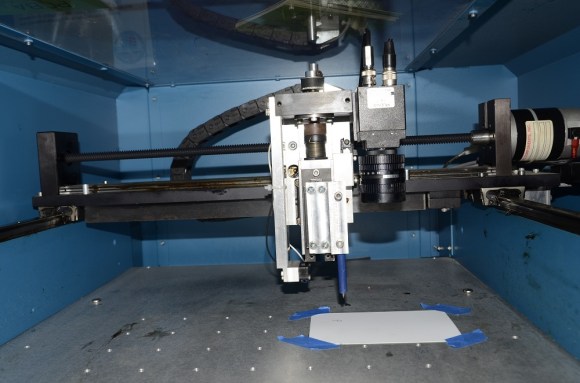
LIB3 is an open source hardware start-up from upstate New York. Thus far, the team has made some interesting products such as the piLED kit. However, they have big dreams for the future. LIB3 plans to become a contract assembly house specifically targeting low volume makers. To do this they have to build their own tools. LIB3’s latest project is a solder paste dispenser for surface mount components. Traditionally solder paste is applied with stencils made of stainless steel. In more recent years laser cut kapton has become a favorite for low volume production.
Both of these systems require a stencil to be made up. LIB3 took a different approach, and modified an old CNC glue dispenser for paste. The team got their hands on an 1991 vintage X/Y glue dispensing system. X/Y systems in this era were big, heavy affairs with powerful motors. LIB3 removed all the control electronics and built their own system from scratch. New features include direct computer control, and a vision system.
For their Maker Faire demo LIB3 replaced the paste with a standard felt tipped pen. Any mouse motion on the attached PC was directly translated into pen motion. The modified machine is extremely accurate – 0603 resistor pads will be no problem. The machine is also incredibly fast. A quick jiggle of the mouse translated into the machine moving its 100 pound head around in a rather frightening manner. Even so, the motors didn’t lose any steps. The machine came right back its home position, ready for the next challenge.
















so, hack?
So hack. Modified CNC glue system to instead spread paste so you don’t have to make stencils to solder SMT components.
Are you sure? I thought it was a paste applying machine to start with.
The fact that they replaced all the control circuitry (proprietary protocol I guess?) with their own is a hack though.
Yes, yes it is!
Have you not caught on that HackADay also features articles about things of interest to the hacker community? That community also includes hobby electronics, and this article is about a potential way for hobby electronics to get professional quality circuits made up for a reasonable price.
So while it’s not focusing on the hack part of the whole affair, it’s of interest to people that want a good quality circuit board to put in their hack.
What stepper engines are those. Gotta have em! Or is it dc motors with rotary encoders that makes it possible to be so fast and accurate?
Servo motors with encoders
“LIB3 removed all the control electronics and built their own system from scratch.”
removed extrely accurate, encoder based systems in favor of stepper motor crap.
great job.
Steppers are not intrinsically innacurate, accuracy depends on your ballscrews or rails mainly.
Steppers are very accurate if they are well configured. Also you can add encoders to your steppers to get the closed loop.
I’m guessing.. and I admit, this isn’t even an educated guess that those control electronics probably spoke some proprietary protocol that required some unavailable software that once sold for 10s of thousands of dollars and only runs under MSDOS or maybe Windows 95.
You would be correct – we never actually had the original control software, but the interface card was ISA. All the pid control was done on the ISA card, and communication between the ISA card and the servo amplifier was with 0-10V analog lines… We replaced the ISA card with a Cypress PSOC, and rebuilt most of the servo amplifier to allow PWM use instead of analog lines. The motors are DC motors with quadrature encoders – we are dealing with the quadrature with decoders implemented in the CPLD blocks of the PSOC. The machine was originally set up for dispensing some sort of industrial 2 part epoxy – the resin was mixed near the nozzle, and forced out with air pressure. Obviously this approach doesn’t work too well for solder paste, especially when we need precise and repeatable volume drops. We have experimented with a variety of dispenser methods, with the most successful being an auger type system, with air pressure to force the paste into the auger.
I remember in college a guy in the physics department asked me if I knew a way to get Windows 3.1 working on a modern machine (this was around 2007). My response was “yes, also you have my sincerest condolences.” Never found out what he was trying to do but I got Win 3.1 working in Dosbox.
I got some old DOS/Win 3.1 Motorola mobile radio programming software working for my dad by running it in VMware Player and using a USB->Serial adapter to hook up the interface cable.
Looks like a DC motor with an encoder.
Or closed loop servos? Could also have an encoder.
“…1991 vintage…”
Hey! Stop making me feel old!
There’s no writing or images or video or anything. The link just goes to their e-store. I don’t know why this is posted on HaD.
Not impressed with their previous project either: http://www.kickstarter.com/projects/2113011562/programmable-intelligent-led-development-system-pi/comments
Well back in the 90’s we had paste dispensing robots just like the above, then moved to stencils, and now full circle back to dispensers.